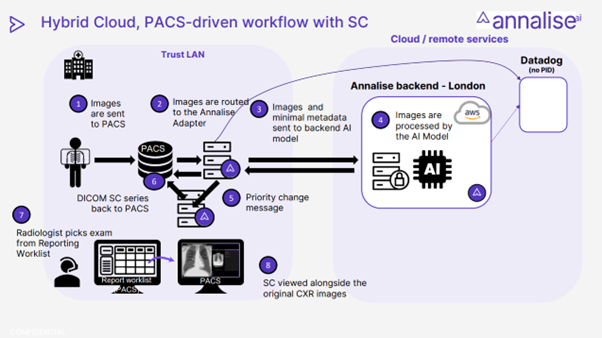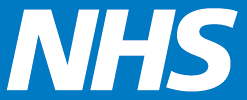Annalise AI training documents
Annalise AI training videos
Annalise AI FAQs
These FAQs pertain to all trusts involved in the Yorkshire Imaging Collaborative.
These FAQs will be updated regularly to ensure information is up to date. Last updated 30 September 2024.
Q1. What is the Annalise.ai Chest X-Ray tool, and what will it do?
Annalise.AI is a piece of software which carries out initial analysis and labelling of abnormalities on chest x-rays within one minute of their acquisition.
It generates secondary capture images in addition to the originals, containing labelled annotations of abnormalities which will be sent to the hospital PACS. These images will be immediately available to anybody authorised to access them and is intended to result in faster front line medical decisions.
Annalise.ai is a clinical decision support tool, and in no way replaces the formal reporting processes in the radiology department. Traditionally, there has been a period of waiting for such reports and this AI product provides an additional layer of information at the point of first line clinical care, before that formal report becomes available.
The AI tool does not change clinical responsibility for reporting or acting upon diagnostic imaging.
Q2. Can clinicians use the tool for clinical practice?
Absolutely, the chosen tool has passed all required UK licensing requirements as clinical decision support software, and has been used live in NHS clinical settings for extended periods of time in other areas. The tool works best when all clinicians can see the outputs of the AI analysis within a short period of the acquisition of the radiograph.
The Yorkshire Imaging Collaborative (YIC) AI Board, in conjunction with the YIC Chest Special Interest Group, has carried out a careful evaluation of the sensitivities and specificities of the different features. It has been decided to switch on a number of features that will be deployed throughout the network (see Q4).
Q3. Will the results be integrated into PACS work lists?
Initially, the solution will be delivered into live clinical use, using the DICOM secondary capture methodology. This means that very soon after the acquisition of a study, it will be analysed by the AI software and delivered alongside the original study, to both the radiology PACS and Xero viewer. However, at the point of implementation, there will be no enhanced prioritisation on the radiology work list.
In a second, fully YIC funded phase of work, AGFA, our Enterprise PACS partner, will carry out deeper integration work into Enterprise Imaging, so that abnormal examinations are correctly labelled on the work list. This supplementary metadata will allow the creation of sophisticated AI driven workflows within the familiar enterprise imaging task list environment, and will be configurable at trust level.
Q4. How will Annalise be implemented consistently across YIC?
The set of features that the AI will look for will be standardised across the YIC network deployment. The YIC AI Board and Chest Special Interest Group, which includes chest physicians and chest radiologists, has reviewed the feature set and selected the features to enable.
Selected features will focus on our three clinical pathways of choice:
- Faster treatment of chest derived sepsis.
- Reducing never events related to misplaced nasogastric tubes
- Early detection of lung cancer on the chest radiograph
This is essential that the feature implementation list is standardised across the YIC trusts – reporters and clinicians need to be able to trust and depend on the results from the AI tool in terms of expectations. For example, if Hospital A decided not to implement pneumothorax detection whilst Hospital B did have the feature switched on, this would create an unsafe disparity.
Q5. Will we be able to tweak the settings individually for our own trust?
It is vital for safety that there is consistency in feature support across the integrated imaging network. As such, specific AI features active at any point in time will be standardised across the YIC network partners.
There is plenty of autonomy available within the existing solution in how you do implement the prioritisation of reporting of work. Our Enterprise PACS partner, AGFA, have been commissioned to help implement these workflows and will support you to build task lists, priorities and alerts based on the AI output.
Q6. How will YIC manage errors and learning relating to the use of the AI tool?
YIC will monitor errors and AI learning at the well-established radiology learning event (REALM), which takes place every month. Cases will be reported and submitted via a digital form, then picked up and reviewed in the monthly meeting. The cases will also be fed back to Annalise for review and feedback. It is recommended that trusts put in place similar processes.
YIC is a national pioneer in extending REALM process to incorporate AI post-market surveillance analysis.
Q7. When will the licence end for my trust?
The Annalise contract for YIC runs from 1 April 24 to 31 March 2026. YIC will monitor usage throughout the contract. Contract management will need to ensure we use up our purchased volumes appropriately.
Q8. Does the AI software use our data to train itself?
No, this is an off-the-shelf AI solution that is already fully trained and has gone through strict regulatory approval on that basis. Our data is not being used by Annalise to train further iterations of the AI software. The AI will therefore not morph over time and should provide consistent analysis. Annalise may release further upgrades to its AI tool, but these would have to go through further approval.
Q9. What happens if the AI gets it wrong?
The AI is a clinical decision support tool – clinicians’ expertise ultimately prevails over the AI and responsibility will continue to lie with the individual reviewing the image and the AI outputs. Radiology departments will continue to report on images as before.
The monthly meeting will review any AI discrepancies so we can review error themes and feed back to Annalise. It is recommended that trusts put in place similar processes.
Q10. Do we need to obtain patient consent if this is a trial? Can patients opt out?
This is not a trial in the sense that we are experimenting with something new. The Annalise.ai product is in widespread use in the NHS and is proven in its trials. This is a trial for NHS England to determine if this a cost-effective solution for them to fund more widely across NHS trusts.
This will become a new standard of care in patient pathways, as such patients cannot opt out of the AI analysis. Decisions remain the responsibility of clinicians.
Q11. Does this automate the reporting of results and therefore have significant influence on patient care outcomes?
The final formal report is still being issued by a human, as current practice. The AI product will influence decision making, but the final, formal report will be produced by human reporters.
Q12. How does data flow between the trust and Annalise?
Only anonymised image data will flow outside of the confines of the trust network environment. This anonymised data will be transmitted over a fully encrypted and secure Virtual Private Network (VPN) to the supplier.
Please see below diagram provided by the solution vendor.

Q13. Where can I access training for this product?
Training documents provided by Annalise:









